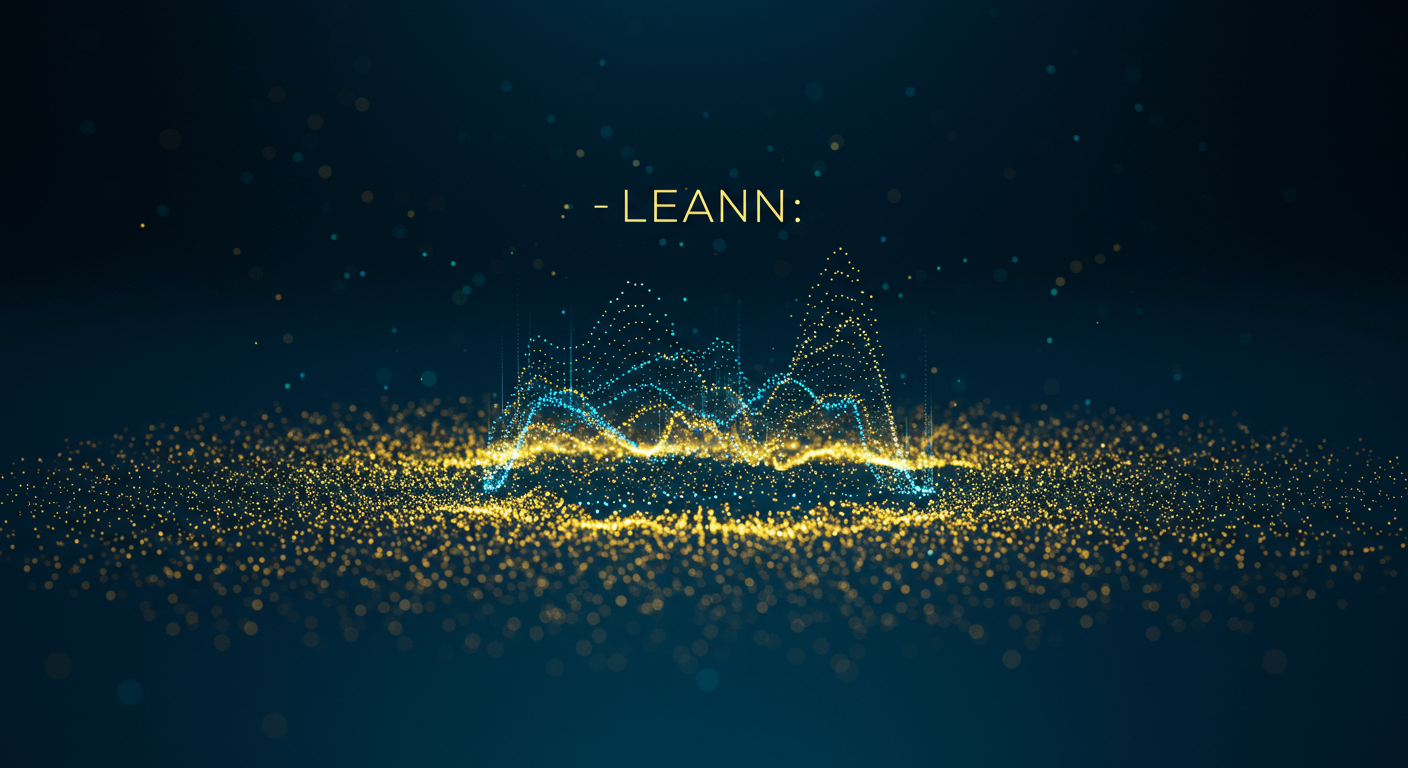LEANN: Democratizing AI with the Tiniest, Most Efficient Vector Database

Here's how LEANN, a "little" vector database, is proving that big things really do come in small packages.
What Makes LEANN Special?
Traditional vector databases are, let's face it, resource hogs. LEANN flips the script with a design that's tiny and storage-efficient – think a nimble microcar versus a gas-guzzling SUV. The primary LEANN vector database benefits stem from its ability to run on resource-constrained devices without sacrificing search performance.
"LEANN lets you put AI where it actually is – closer to the data."
Democratizing AI Access
LEANN isn't just about saving space; it's about leveling the playing field. By minimizing storage requirements, it democratizes AI, bringing sophisticated vector search capabilities to a wider audience. Imagine personal AI assistants running smoothly on your phone or edge computing devices handling complex tasks without breaking a sweat. You can explore other Data Analytics tools for related tasks.
Applications and Advantages
LEANN shines in applications where size matters:
- Personal AI: On-device assistants that understand your needs.
- Edge Computing: Real-time analysis and decision-making on IoT devices.
- Mobile Applications: Enhancing app functionality without bloating storage.
In short, LEANN's design allows it to empower a range of applications in personal AI and edge computing.
The democratization of AI takes a leap forward with LEANN, a revolutionary vector database packing immense power into an incredibly small footprint.
The Power of Compression: LEANN Architecture Explained

How does LEANN achieve its remarkable size and efficiency? It’s all about clever design and strategic trade-offs.
Approximate Nearest Neighbor (ANN) Search: LEANN hinges on ANN search. Instead of exhaustively comparing every vector, ANN algorithms find near* neighbors, sacrificing some accuracy for a massive speed boost.
- Algorithms at Play: It often leverages techniques like Hierarchical Navigable Small World (HNSW) graphs and Inverted File (IVF) indices to accelerate similarity searches. This is covered more in-depth in our AI Fundamentals guide.
- Accuracy vs. Efficiency: The trade-off is crucial. A perfect match (high accuracy) takes time, but a "good enough" match (high efficiency) is often sufficient for many real-world applications. Think of it like this: > You're looking for a specific shade of blue paint. Do you examine every single paint chip ever made, or do you narrow it down to blues and then pick the closest match? LEANN favors the latter.
- Storage Efficiency: It implements smart compression techniques to minimize storage space. Think of it as lossless compression for your AI brainpower.
Putting it All Together
The LEANN architecture explained boils down to optimizing for the essential: speed and size, without crippling accuracy. This is achieved through clever algorithm choices, data compression and accepting "good enough" instead of perfect results in the quest for speed. This approach could have a large impact on productivity collaboration tools.Ready to explore more ways AI is revolutionizing the world?
LEANN promises to bring powerful AI to even the smallest devices. But how does this storage-efficient vector database translate into tangible benefits?
LEANN Powers Personal AI Assistants
Imagine a truly personal AI assistant, living entirely on your device. LEANN (Learn more about LEANN and how it works here) makes this possible by enabling complex AI models to run without needing vast cloud resources.Think of it like this: your assistant knows you intimately, not just statistically.
AI at the Edge: Smartphones, Wearables, and IoT
Smartphones, wearables, and IoT sensors are resource-constrained environments. Here's where LEANN truly shines:- Smartphones: Faster image recognition, natural language processing, and personalized recommendations—all without draining your battery.
- Wearables: Real-time health monitoring with AI-powered anomaly detection—think instant alerts for potential heart issues.
- IoT Sensors: Smarter security cameras, energy-efficient smart homes, and optimized industrial processes.
LEANN in Resource-Constrained Environments
LEANN isn’t just for consumer gadgets; it’s perfect for environments where resources are scarce. In remote areas, or in disaster relief efforts, offline AI can provide critical assistance without needing a stable internet connection.LEANN Use Cases Examples
- Recommendation systems: Improved accuracy in personalized product suggestions.
- Image retrieval: Lightning-fast image searching on-device using semantic similarity.
- Natural language processing: More responsive and context-aware speech recognition, even offline.
Ultimately, LEANN's ability to democratize AI is its most exciting feature – paving the way for innovation.
LEANN is changing the game, but how does it stack up against the established players?
LEANN vs. The Giants: Comparing to Existing Vector Database Solutions
Vector databases are critical for AI applications, enabling efficient similarity searches. While LEANN shines in resource-constrained settings, let's see how it compares to more established solutions.
Size and Storage Efficiency
LEANN's key advantage lies in its minimal footprint. This contrasts sharply with larger databases:
- Pinecone: A fully managed service, Pinecone offers scalability but demands significant resources.
- Weaviate: An open-source, cloud-native vector database, Weaviate still needs considerable resources to operate efficiently.
- Milvus: Designed for massive-scale vector similarity searches, Milvus can be overkill for smaller deployments.
Performance & Cost
The 'LEANN vs Pinecone performance' question is a common one. Consider the trade-offs:
- LEANN: High performance in small-scale, memory-constrained scenarios. Lower operational costs due to minimal resource requirements.
- Pinecone, Weaviate, Milvus: Designed for large-scale datasets and high query volumes. Higher infrastructure costs due to more demanding resource requirements.
Pros and Cons

| Feature | LEANN | Pinecone | Weaviate | Milvus |
|---|---|---|---|---|
| Size | Tiny | Large | Medium | Large |
| Storage | Highly Efficient | Less Efficient | Efficient | Less Efficient |
| Performance | Excellent (Small Scale) | Excellent (Large Scale) | Good (Scalable) | Excellent (Massive Scale) |
| Cost | Minimal | High | Medium | High |
| Resource Needs | Very Low | High | Medium | High |
| Scalability | Limited | Excellent | Good | Excellent |
While LEANN might not be the best for handling billions of vectors, its resource efficiency makes it perfect for democratizing AI in places where "big iron" simply isn't feasible or affordable. To see more vector database options, check out the AI tool directory.
Democratizing AI means empowering everyone with efficient tools. That's where LEANN comes in.
Getting Started with LEANN: A Developer's Guide to Implementation
Ready to dive into LEANN, the leanest vector database around? This implementation guide provides a streamlined roadmap for developers. LEANN democratizes AI by reducing infrastructure overhead.
Installation and Configuration
- Install the LEANN library: Using pip:
pip install leann(or your preferred package manager). - Configure your environment: LEANN plays nicely with Python and integrates into your existing AI pipelines.
- Link documentation and resources: Refer to the official LEANN documentation for detailed configuration options and troubleshooting.
Basic Code Examples
- Creating a Vector Index:
python
from leann import VectorIndexindex = VectorIndex(dimensions=128) # Dimensions match your vector embeddings
- Indexing Vectors:
python
index.add(vector=[0.1, 0.2, ..., 0.9], item_id="item_1")
- Searching for Nearest Neighbors:
python
results = index.search(query_vector=[0.3, 0.4, ..., 0.7], top_k=10)
print(results)
Adapt these snippets to your specific needs; consult the Software Developer Tools category for complementary libraries.
Optimization and Best Practices
- Hardware Considerations: Optimize LEANN by tweaking the configuration; test using realistic data.
- Data Preparation: Preprocess your data diligently; use appropriate embedding models for optimal results. Explore Learn AI Fundamentals for more background on data processing.
- Consider quantization: Quantization techniques are essential for boosting speed.
LEANN: Democratizing AI with the Tiniest, Most Efficient Vector Database
The Future of LEANN: Roadmap, Community, and Open Source Potential
The journey of LEANN – a vector database designed for resource-constrained environments – is just beginning, and the roadmap ahead is brimming with exciting possibilities.
What's on the Horizon?
- Enhanced Feature Set: Expect continuous improvement and additions to LEANN's core functionalities. Think smarter indexing, faster queries, and greater flexibility in handling various data types. For example, developers specializing in Data Analytics will appreciate more robust tools for processing high dimensional data.
- Seamless Integrations: Streamlining workflows is key. The future includes pre-built integrations with popular AI frameworks and tools. Imagine effortless connections with tools like TensorFlow or PyTorch, reducing integration friction for Software Developers.
Open Source and Community-Driven
"The true power of AI lies in its accessibility."
Open-sourcing LEANN is a significant ambition. It invites a vibrant community to contribute, improve, and tailor the database to niche applications.
- How to Contribute: Developers can engage through code contributions, bug reports, documentation, and feature suggestions. A dedicated forum and GitHub repository (hypothetically) will be central hubs.
- Challenges and Opportunities: The transition to open-source requires careful planning to maintain quality and security. The reward is a more robust, adaptable database driven by diverse expertise. As Guide to Finding the Best AI Tool Directory shows, open source communities become crucial.
Here's a LEANN troubleshooting guide to help you overcome the common hurdles developers face.
Overcoming Common Challenges with LEANN: Troubleshooting and Optimization Tips
Ready to dive into the exciting world of LEANN? LEANN is a lightweight, efficient vector database, but even the most streamlined tools can present challenges. Let's tackle common issues and optimize your experience!
Performance Bottlenecks & Memory Constraints
Is LEANN slowing you down? Running out of memory?
- Indexing Optimization: Experiment with different indexing methods and parameters in LEANN.
- Vector Size Reduction: If you’re hitting memory limits, consider reducing the dimensionality of your vectors. Techniques like PCA (Principal Component Analysis) can help.
- Quantization: Explore using quantization techniques to reduce the memory footprint of your vectors without sacrificing too much accuracy.
Large Datasets & High-Dimensional Vectors
Handling massive datasets or vectors with hundreds or thousands of dimensions?
- Sharding: Split your dataset into smaller, manageable shards.
- Approximate Nearest Neighbor (ANN) Search: Implement ANN algorithms (which many vector DBs use, including LEANN). This increases speed for large datasets at the expense of some accuracy.
- Indexing Strategies: Consider hierarchical navigable small world (HNSW) indexing if LEANN supports it, a fast and efficient indexing method.
Common LEANN Troubleshooting FAQ
- Q: My queries are returning incorrect results. What's happening? A: Double-check your distance metric and indexing parameters. Make sure your query vector is normalized the same way your indexed vectors are.
- Q: How do I monitor LEANN's performance? A: Monitor CPU usage, memory consumption, and query latency. Implement logging to track errors and identify potential bottlenecks.
Keywords
vector database, LEANN vector database, approximate nearest neighbor search, ANN search index, storage efficient AI, personal AI, edge AI, tiny vector database, democratizing AI, AI for everyone, efficient AI search, resource-constrained AI, embedded AI
Hashtags
#VectorDatabase #AI #ApproximateNearestNeighbor #LEANN #PersonalAI
Recommended AI tools
ChatGPT
Conversational AI
AI research, productivity, and conversation—smarter thinking, deeper insights.
Sora
Video Generation
Create stunning, realistic videos and audio from text, images, or video—remix and collaborate with Sora, OpenAI’s advanced generative video app.
Google Gemini
Conversational AI
Your everyday Google AI assistant for creativity, research, and productivity
Perplexity
Search & Discovery
Clear answers from reliable sources, powered by AI.
DeepSeek
Conversational AI
Efficient open-weight AI models for advanced reasoning and research
Freepik AI Image Generator
Image Generation
Generate on-brand AI images from text, sketches, or photos—fast, realistic, and ready for commercial use.
About the Author

Written by
Dr. William Bobos
Dr. William Bobos (known as 'Dr. Bob') is a long-time AI expert focused on practical evaluations of AI tools and frameworks. He frequently tests new releases, reads academic papers, and tracks industry news to translate breakthroughs into real-world use. At Best AI Tools, he curates clear, actionable insights for builders, researchers, and decision-makers.
More from Dr.

